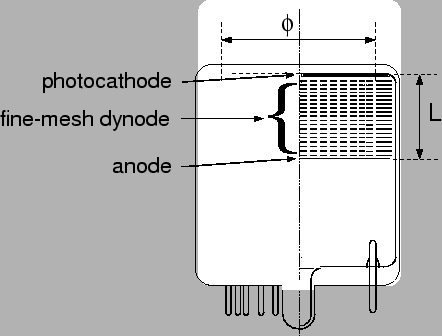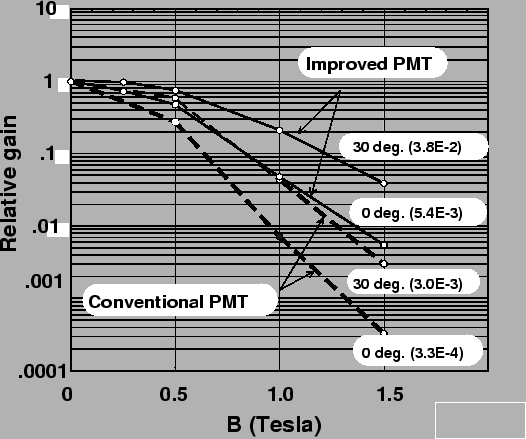



Next: ACC Readout Electronics
Up: Detector Design
Previous: Quality of the aerogels
Contents
Since ACC is placed in a high magnetic field of 1.5 T in the Belle
detector, we decided to use fine-mesh photomultiplier tubes (FM-PMTs)
for the detection of Cerenkov lights, taking advantage of its
large effective area and high gain [44]. Other
candidate photo-sensors such as microchannel-plate photomultiplier
tubes (MCP-PMT) and hybrid photodiodes (HPD) were still at R&D stages
or extremely expensive when this decision was made. The FM-PMTs were
produced by Hamamatsu Photonics [49].
A sectional view of an FM-PMT is shown in
Fig. ![[*]](./icons/crossref.png) . Each FM-PMT has a borosilicate glass
window, a bialkali photo-cathode, 19 fine-mesh dynodes, and an
anode. Three types of FM-PMTs of 2, 2.5, and 3 inches in diameter are
used in ACC. The effective diameters (
. Each FM-PMT has a borosilicate glass
window, a bialkali photo-cathode, 19 fine-mesh dynodes, and an
anode. Three types of FM-PMTs of 2, 2.5, and 3 inches in diameter are
used in ACC. The effective diameters ( ) of these FM-PMTs are
39, 51, and 64 mm. The cathode-to-anode distance (
) of these FM-PMTs are
39, 51, and 64 mm. The cathode-to-anode distance ( ) is about 20
mm. The average quantum efficiency of the photo-cathode is 25 % at
400 nm wavelength. The optical opening of the mesh is about 50 %.
) is about 20
mm. The average quantum efficiency of the photo-cathode is 25 % at
400 nm wavelength. The optical opening of the mesh is about 50 %.
Figure:
Sectional view of FM-PMT.
 |
The FM-PMTs with 19 dynode stages of fine mesh have high gain ( ) with moderate HV values (
) with moderate HV values ( 2500 V). The gain of FM-PMT
decreases as a function of field strength as shown in
Fig.
2500 V). The gain of FM-PMT
decreases as a function of field strength as shown in
Fig. ![[*]](./icons/crossref.png) . The gain reduction is
. The gain reduction is  for
FM-PMTs placed parallel to the direction of magnetic field and
slightly recovers when they are tilted. The FM-PMTs used for ACC were
produced with dynodes with a finer mesh spacing than conventional
products at that time, to give approximately 10 times higher gain as
shown in in Fig.
for
FM-PMTs placed parallel to the direction of magnetic field and
slightly recovers when they are tilted. The FM-PMTs used for ACC were
produced with dynodes with a finer mesh spacing than conventional
products at that time, to give approximately 10 times higher gain as
shown in in Fig. ![[*]](./icons/crossref.png) .
.
Figure:
Relative gains of conventional and improved FM-PMTs in
magnetic fields. The tubes were placed parallel (0 ) or tilted by
30
) or tilted by
30 with respect to the field direction.
with respect to the field direction.
 |
Effects of a magnetic field on the pulse height resolution have been
evaluated by tracing the change of a quantity  , which is
defined as
, which is
defined as
 , by using the mean (
, by using the mean ( ) and
sigma (
) and
sigma ( ) of the recorded ADC spectrum. The quantity
) of the recorded ADC spectrum. The quantity  represents the effective photostatistics for the spectrum, which is a
convolution of a single-photoelectron (pe) response of the device and
the Poisson statistics with
represents the effective photostatistics for the spectrum, which is a
convolution of a single-photoelectron (pe) response of the device and
the Poisson statistics with  , the average number of
photoelectrons emitted from the photo-cathode. For FM-PMTs, the ratio
, the average number of
photoelectrons emitted from the photo-cathode. For FM-PMTs, the ratio
 is about 2 at
is about 2 at  = 0. The relatively large excess
noise factor is due to the fact that a single-photoelectron spectrum
does not have any characteristic peak [50].
Reduction of
= 0. The relatively large excess
noise factor is due to the fact that a single-photoelectron spectrum
does not have any characteristic peak [50].
Reduction of  in a magnetic field has been measured for 2
in., 2.5 in. and 3 in. FM-PMTs, with
in a magnetic field has been measured for 2
in., 2.5 in. and 3 in. FM-PMTs, with  at
at  = 0
(
= 0
( ) of about 20.
Table
) of about 20.
Table ![[*]](./icons/crossref.png) shows the ratio
shows the ratio
 at
at  = 1.5 T for
two ranges of applied HVs. As the field
= 1.5 T for
two ranges of applied HVs. As the field  increases, the resolution
deteriorates and the quantity
increases, the resolution
deteriorates and the quantity  decreases. The decrease in
decreases. The decrease in
 is larger when the field is at a large angle such as 30
is larger when the field is at a large angle such as 30 than the case of
than the case of  , and the decrease in
, and the decrease in  at a
large angle is more significant for smaller FM-PMTs. However, it is
noticed that, in a magnetic field, the resolution improves, namely the
quantity
at a
large angle is more significant for smaller FM-PMTs. However, it is
noticed that, in a magnetic field, the resolution improves, namely the
quantity  increases, by applying higher voltage, while no
significant change is found in absence of the field.
increases, by applying higher voltage, while no
significant change is found in absence of the field.
Table:
Measured ratio
 at B = 1.5 T. The number
of tested samples for each condition is shown in parentheses.
at B = 1.5 T. The number
of tested samples for each condition is shown in parentheses.
| PMT |
2000 - 2200 V |
2600 - 2800 V |
| diam. |
|
|
|
|
| |
 = 0 = 0 |
 = 30 = 30 |
 = 0 = 0 |
 = 30 = 30 |
| 2 |
0.74 (7) |
0.64 (10) |
0.75 (10) |
0.73 (10) |
| 2.5 |
0.80 (5) |
0.73 (5) |
0.85 (8) |
0.85 (8) |
| 3 |
0.79 (2) |
0.77 (4) |
0.87 (6) |
0.99 (7) |




Next: ACC Readout Electronics
Up: Detector Design
Previous: Quality of the aerogels
Contents
Samo Stanic
2001-06-02

